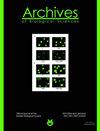Structure and function of benthic invertebrate assemblages of the Djerekarska River (southwestern Serbia, Pester plateau)
IF 0.8
4区 生物学
Q4 BIOLOGY
引用次数: 0
Abstract
This study is focused on benthic invertebrate communities in the Djerekarska River in Serbia, sampled from June to December 2016. We examined how different microhabitats with various substrates influenced the structure and function of the community. Taxonomic analysis revealed 55 species from 43 genera and 35 families, with the most diverse groups being Trichoptera, Ephemeroptera, and Plecoptera. ANOVA showed that different substrate types impacted the functional feeding groups within the assemblages. Cluster formation was primarily influenced by the substrate structure; this was followed by shredders, gatherers and collectors, passive filters, active filter feeders, the river depth, biochemical oxygen demand, chemical oxygen demand, and the flow velocity; for grazers and scrapers, discharge and saturation did not significantly affect cluster formation. Using twostep cluster analysis, we identified three clusters based on the substrate structure. The first group consisted of organisms that prefer a stone substrate; the second group consisted of organisms that prefer a mixed stone/gravel/sand substrate; the third group consisted of organisms that prefer gravel and sand substrates. Each cluster had a dominant functional feeding group, such as shredders and predators in the first cluster, gatherers and collectors in the second cluster, and predators, grazers, and scrapers in the third cluster.塞尔维亚西南部佩斯特高原杰里卡尔斯卡河底栖无脊椎动物群落的结构与功能
本研究的重点是2016年6月至12月在塞尔维亚杰里卡尔斯卡河取样的底栖无脊椎动物群落。研究了不同基质微生境对群落结构和功能的影响。分类结果显示,该昆虫隶属于35科43属55种,类群以毛翅目、蜉蝣目和翼翅目最为丰富。方差分析表明,不同的底物类型影响了组合内的功能摄食基团。簇的形成主要受衬底结构的影响;其次是碎纸机、采集机和收集器、被动过滤器、主动过滤器、河流深度、生化需氧量、化学需氧量和流速;对于放牧者和刮削者,流量和饱和度对集群的形成没有显著影响。利用两步聚类分析,我们根据衬底结构确定了三个聚类。第一组由喜欢石头基质的生物组成;第二组生物喜欢混合的石头/砾石/沙子基质;第三组由偏爱砾石和沙子基质的生物组成。每个集群都有一个优势的功能捕食群体,如撕碎者和捕食者为第一集群,采集者和收集者为第二集群,捕食者、食草者和刮削者为第三集群。
本文章由计算机程序翻译,如有差异,请以英文原文为准。
求助全文
约1分钟内获得全文
求助全文
来源期刊
CiteScore
1.40
自引率
0.00%
发文量
25
审稿时长
3-8 weeks
期刊介绍:
The Archives of Biological Sciences is a multidisciplinary journal that covers original research in a wide range of subjects in life science, including biology, ecology, human biology and biomedical research.
The Archives of Biological Sciences features articles in genetics, botany and zoology (including higher and lower terrestrial and aquatic plants and animals, prokaryote biology, algology, mycology, entomology, etc.); biological systematics; evolution; biochemistry, molecular and cell biology, including all aspects of normal cell functioning, from embryonic to differentiated tissues and in different pathological states; physiology, including chronobiology, thermal biology, cryobiology; radiobiology; neurobiology; immunology, including human immunology; human biology, including the biological basis of specific human pathologies and disease management.

 求助内容:
求助内容: 应助结果提醒方式:
应助结果提醒方式:


